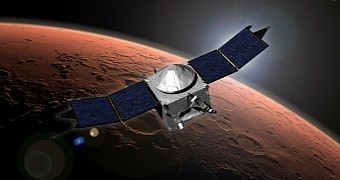NASA is thrilled to announce that, this past weekend, its MAVEN spacecraft finally reached Mars and started orbiting it. More precisely, it was late Sunday that this probe made it to the Red Planet, and got caught by its gravity.
Information shared with the public says that, in order to reach Mars, the probe spent about 10 months journeying through space. Thus, the spacecraft left Earth on November 18, 2013. It was sent on its way by an Atlas V launch vehicle.
The first spacecraft to study Mars' upper atmosphere
As detailed by NASA scientists, the MAVEN spacecraft, whose name is an acronym for Mars Atmosphere and Volatile Evolution, was sent to the Red Planet not to study its landscape or the makeup of its soils, but to research the Martian upper atmosphere.
Interestingly enough, this probe is the first ever to boast such a working agenda. It is expected that, with MAVEN's help, scientists will reach a better understanding of how the Red Planet's atmosphere has changed over time.
Information obtained in this manner should pave the way for future Mars missions involving human astronauts. In fact, NASA believes that it will manage to land people on the Red Planet in just a few years, and hopes that MAVEN will help it achieve this goal.
“As the first orbiter dedicated to studying Mars’ upper atmosphere, MAVEN will greatly improve our understanding of the history of the Martian atmosphere, how the climate has changed over time, and how that has influenced the evolution of the surface and the potential habitability of the planet.”
“It also will better inform a future mission to send humans to the Red Planet in the 2030s,” NASA Administrator Charles Bolden commented on the importance of this research project in a recent interview with the press.
What exactly will the MAVEN spacecraft do?
While orbiting the Red Planet, this NASA spacecraft will use the scientific instruments that it is fitted with to study gas escape from the Martian atmosphere. Its goal will be to understand how and why Mars switched from being a fairly warm and wet place to being the arid and cold world it now is.
Scientists believe that this extreme makeover was brought about by changes in the planet's atmosphere. In turn, these changes are likely to have occurred due to the influence of solar winds. However, until MAVEN gets to work studying the Red Planet, there is no way to tell what actually happened.
“What we're going to be doing is studying the top of the atmosphere as a way of understanding the extent to which stripping of gas out of the atmosphere to space may have been the driving mechanism behind climate change,” mission principal investigator Bruce Jakosky said in a statement, as cited by Space.
“We're trying to understand the context in which life might have existed. Any life on Mars interacts with its planetary environment; we need to know what that environment is, and how it's evolved over time,” the space exploration enthusiast added.
There's another spacecraft on its way to Mars
As reported just a few days ago, one other spacecraft is expected to reach the Red Planet later this month. Thus, a probe named Mangalyaan and launched by the Indian Space Research Organization on November 4, 2013, will too start orbiting Mars this coming September 24.
Unlike MAVEN, Mangalyaan will not study the links between the planet's atmosphere and its climate. On the contrary, this probe will use the 5 instruments it is fitted with to map Mars' surface and shed new light on this planet's makeup.

 14 DAY TRIAL //
14 DAY TRIAL //